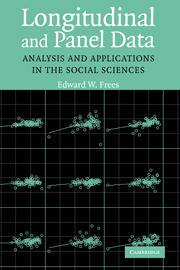Book contents
- Frontmatter
- Contents
- Preface
- 1 Introduction
- 2 Fixed-Effects Models
- 3 Models with Random Effects
- 4 Prediction and Bayesian Inference
- 5 Multilevel Models
- 6 Stochastic Regressors
- 7 Modeling Issues
- 8 Dynamic Models
- 9 Binary Dependent Variables
- 10 Generalized Linear Models
- 11 Categorical Dependent Variables and Survival Models
- Appendix A Elements of Matrix Algebra
- Appendix B Normal Distribution
- Appendix C Likelihood-Based Inference
- Appendix D State Space Model and the Kalman Filter
- Appendix E Symbols and Notation
- Appendix F Selected Longitudinal and Panel Data Sets
- References
- Index
11 - Categorical Dependent Variables and Survival Models
Published online by Cambridge University Press: 05 September 2012
- Frontmatter
- Contents
- Preface
- 1 Introduction
- 2 Fixed-Effects Models
- 3 Models with Random Effects
- 4 Prediction and Bayesian Inference
- 5 Multilevel Models
- 6 Stochastic Regressors
- 7 Modeling Issues
- 8 Dynamic Models
- 9 Binary Dependent Variables
- 10 Generalized Linear Models
- 11 Categorical Dependent Variables and Survival Models
- Appendix A Elements of Matrix Algebra
- Appendix B Normal Distribution
- Appendix C Likelihood-Based Inference
- Appendix D State Space Model and the Kalman Filter
- Appendix E Symbols and Notation
- Appendix F Selected Longitudinal and Panel Data Sets
- References
- Index
Summary
Abstract. Extending Chapter 9, this chapter considers dependent variables having more than two possible categorical alternatives. As in Chapter 9, we often interpret a categorical variable to be an attribute possessed or choice made by an individual, household, or firm. By allowing more than two alternatives, we substantially broaden the scope of applications to complex social science problems of interest.
The pedagogic approach of this chapter follows the pattern established in earlier chapters; we begin with homogeneous models in Section 11.1 followed by the Section 11.2 model that incorporates random effects, thus providing a heterogeneity component. Section 11.3 introduces an alternative method for accommodating time patterns through transition, or Markov, models. Although transition models are applicable in the Chapter 10 generalized linear models, they are particularly useful in the context of categorical dependent variables. Many repeated applications of the idea of transitioning give rise to survival models, another important class of longitudinal models. Section 11.4 develops this link.
Homogeneous Models
We now consider a response that is an unordered categorical variable. We assume that the dependent variable y may take on values 1, 2, …, c, corresponding to c categories. We first introduce the homogenous version so that this section does not use any subject-specific parameters nor introduce terms to account for serial correlation.
In many social science applications, the response categories correspond to attributes possessed or choices made by individuals, households, or firms.
- Type
- Chapter
- Information
- Longitudinal and Panel DataAnalysis and Applications in the Social Sciences, pp. 387 - 416Publisher: Cambridge University PressPrint publication year: 2004



